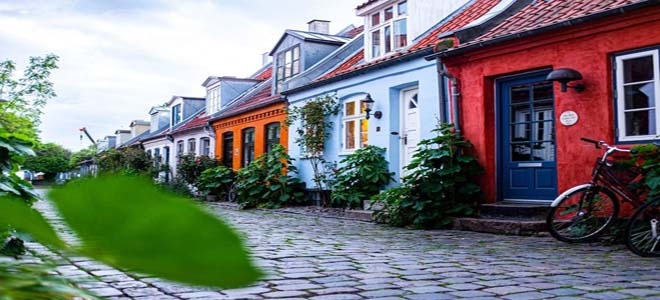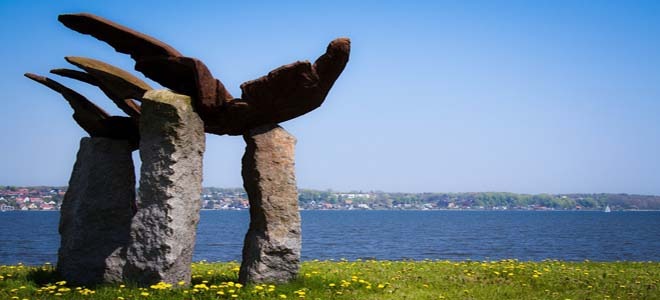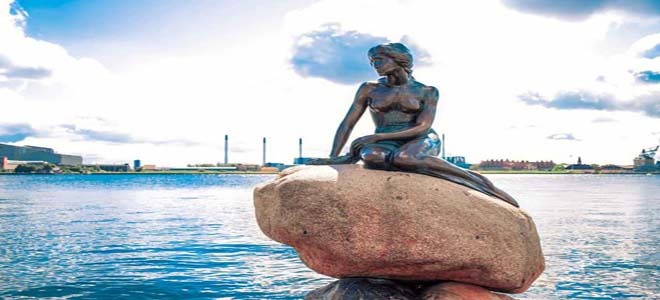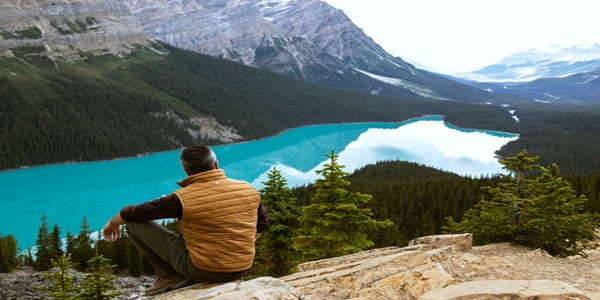Denmark has always been a country that fascinates with its green landscapes, modern and people-friendly cities, friendly and serene atmosphere and delicious gastronomy. It’s a destination for everyone with all the things to do in Denmark. Nature lovers will find themselves at home, as Denmark is one of the greenest countries in the world, with extensive use of clean technologies and cycling in the cities. Families and those who love history and culture will find many interesting ideas, with theme parks, castles and landscapes that inspired Andersen’s most beautiful fairy tales.
One of the best ways to visit Denmark is with a tour on the road, although the efficient public transport services can be a good alternative for those who don’t want to get behind the wheel, but renting a car allows you to have total autonomy and stop in the places that interest you most by customizing your trip. The fairly small size of the country means that 10 days is enough time to see the main things to do in Denmark without too much haste and to help you organize your trip, travelermagazine.net proposes an itinerary idea that includes a bit of everything.
10 days in Denmark, best things to do
Day 1 – Day 2 – What to do in Copenhagen

If, as likely, you will land in Copenhagen, take a couple of days to explore the city. Here you will not need the car, so you can save money and start your rental from the third day. Copenhagen is among the coolest and most environmentally friendly capitals in the world. A modern city but able to preserve its traditions and history. The Centre of Copenhagen is quite cosy, so a couple of days is enough to get a general idea of the city with a simple visit on foot or by bicycle, walking through the romantic canals.
Among the classic things to do in Denmark not to be missed are:
- the statue of the Little Mermaid at the Langelinje pier, which has become a symbol of the city
- the Round Tower with its observatory from which you can enjoy a splendid view
- numerous museums and art galleries where you can immerse yourself in Danish history and culture
- many attractions for families, from the famous Copenhagen Zoo to the theme parks in Tivoli and the aquarium.
In the evening you’ll be spoilt for choice when it comes to restaurants and entertainment; for young people or those who want to stay late, the best neighborhood is Kødbyen, the Danish version of New York’s Meatpacking district.
Day 3 – Copenhagen / Helsingør / Hillerød / Roskilde
On the third day of the trip, drive towards Helsingør, only 50 km from Copenhagen. Among all the things to do in Denmark, Helsingør is one of the most famous and popular places for tourists. Here is the famous Kronborg Castle, also known as Hamlet’s Castle, because a legend linked to this place inspired Shakespeare to his famous tragedy. A short distance away, in the town of Hillerød is another important attraction, the sumptuous Frederiksborg Castle, surrounded by magnificent gardens. It houses a museum dedicated to Danish history and walking through its luxurious rooms you can admire paintings, period furniture, paintings and other works of art.
Read also: Things To Do In Oslo
Day 4 – Things to do in Denmark – Roskilde / Odense

Spend at least half a day visiting Roskilde, a charming city full of things to do in Denmark. Among the things to see there is definitely the Duomo, an extraordinary building that houses the tombs of the Danish monarchs, and the Vikingeskibshallen, the museum of Viking ships where 5 original Viking ships are on display, moored in the fjord right in front of the museum. From Roskilde you can also take a boat ride on the fjord, a great idea to admire the landscape from the water, especially in the summer months.
Leave Roskilde and head to Odense, just over 130 km away. Odense is the fairytale capital and birthplace of Hans Christian Andersen. It’s not hard to see where the writer found inspiration for his fairy tales: the landscape around Odense is enveloped in a fairytale atmosphere, with expanses of greenery dotted with farms, forests and small villages. This region is full of castles, including the enchanting Egeskov Castle, which is about 30 minutes drive from Odense and looks like something out of a fairy tale.
In Odense you can also visit Andersen’s childhood home, where you can admire the first creations made as a child At the Hans Christian Andersen Museum you can learn more about the writer’s private and working life. If you have time on this day or the next morning, visit the old village of Funen nearby: it is an old rural village dating back to 1700 and has been preserved practically intact. Today it is a town-museum, with actors in costume that you will see walking through the streets.
Day 5 – What to do in Odense / Billund
After spending the morning in Odense, you leave for Billund, about 100 km away. Here you will find Legoland, the first park dedicated to the famous bricks. Today it remains the most loved theme park by both children and adults who are Lego fans. You can decide to spend the afternoon here and sleep in the area, or leave for the next stage, Århus.
Read also: Best Things To Do In Sintra
Day 6 – Visit Five Billund / Århus

Århus is about 200 km from Billund and is a pretty port town with a young population and a dynamic atmosphere. Modern and full of attractions and things to do in Denmark, Århus is perfect for a day of total relaxation. You can stroll in the Latin Quarter, the oldest district of the city (dating back to 1300) or in the pedestrian areas full of shops, visit the art galleries and open-air museums, walk along the coast and in the harbour area and admire the runic stones of Jelling. Around Århus you will find beaches, beautiful forests and natural areas to explore.
Day 7 – Things to do in Denmark – Århus / Skagen
Leave Århus and head to Skagen, just over 220 km away. It’s a place you’ll find hard to forget: an oasis of unspoilt nature and silence that stretches to the northern tip of Denmark and attracts tourists for its landscapes where vegetation embraces the white sand dunes on which the waves of the two seas of Skagerrak and Kattegat break, which meet at this very spot.
You can spend a whole day in this small town with its narrow shopping streets, traditional houses, numerous bars and restaurants where you can enjoy fish specialties. Just a few kilometres south of the town lies the Råbjerg Mile Desert, an immense sand desert nestled on the moor, which moves 15 metres every year, driven by the wind.
Day 8 – Explore Skagen / Ribe
Back south. You leave early to reach the historic town of Ribe, about 340 km away. It is the oldest city in Denmark and still retains its beauty unchanged. It boasts a beautiful centre with a medieval atmosphere, with wooden houses, cobbled alleys, monasteries and the beautiful cathedral, with its tower from which you can enjoy a wonderful view of the city. Don’t miss the interesting Viking museum among the things to do in Denmark.
Read also: Best beaches in Spain
Day 9 – Visit Ribe / Kolding

It’s about an hour’s drive to the ancient harbour town of Kolding, which boasts many historical sites, including the sumptuous Koldinghus Castle which dominates the town and offers beautiful views of the fjord. Kolding is a perfect blend of history and modernity. It also has many things to do and places to shop, including the Storecenter shopping centre, one of the largest on the Jutland peninsula.
Day 10 – Things to do in Denmark – Kolding / Copenhagen
There are about 250 km between Kolding and Copenhagen. Take this last day to relax, enjoy the journey on the road admiring the landscapes of Denmark and, once in Copenhagen, hand over your car and rest while waiting for your return home.
25 more things to do in Denmark

Many people know it simply as Denmark, but this is actually the Kingdom of Denmark thanks to the royal family that has resided here for centuries and made it a sovereign state. As a result, palaces and castles are strongly present in the landscape and if you are a history buff, there is a lot to appreciate.
Probably a number of Denmark’s best attractions, however, happen outdoors, as this country is home to some of the most incredible natural attractions on earth, such as floating sand dunes that change location every year and majestic cliffs that carry 65 million years of history. As if that weren’t enough, you can explore some of the islands off the country’s main coast, where you’ll find vast pine forests, wild horses and relaxing seals.
Depending on your interests, you can take a trip back in time to learn all about the Viking roots of the smallest country in the Nordic region, or advance rapidly into the future in some of the world’s most avant-garde museums such as the Maritime Museum or the AroS Art Museum.
Let’s explore the best things to do in Denmark:
1. Visit the animals at Copenhagen Zoo
Copenhagen Zoo has the reputation of being one of the oldest zoos in Europe and was first opened in 1859. The zoo covers 27 acres of land and here you’ll find 264 different species as over 3,000 animals call the zoo home. The area is made up of different sections such as the tropical zoo which covers 1,500 square meters and imitates the conditions of the rainforest and here you will find animals such as deer, snakes and crocodiles and a butterfly garden.
For younger visitors there is a children’s zoo and you can get close to animals like the dwarf goats of Africa.
Read also: Most Beautiful City In Switzerland
2. Discover Your national park
Your national park is the first official national park in Denmark and covers 12 kilometres of land along the west coast of Jutland. Here you’ll find rugged landscapes, vast pine forests and invigorating sea air. Hiking and cycling are both popular activities in the park, and you can stroll through scenic sand dunes while admiring the local flora and fauna.
Birdwatchers are also in search of a surprise as there are over 30 species of birds in the park, as well as resident otters. In addition to the wildlife found here, you can also admire the burial mounds that dot the site and date from the Bronze Age.
3. Climb the Råbjerg Mile
Next to Skagen in North Jutland is the largest moving sand dune in northern Europe. The Råbjerg Mile moves at a speed of about 18 metres a year, and you can still see the route it has traced through the surrounding landscapes as the sands passed by noisily. This is one of best things to do in Denmark and over 250,000 people come here every year to marvel at this extraordinary feat of nature.
4. Visit Egeskov Castle in Funen
Egeskov is one of the most beautiful and famous buildings in Europe and is built in Renaissance style. Points of interest to pay attention to if you come here include the mighty Knights’ Hall, as well as elegant spires and a working moat. The area around the castle is as famous as the interior and you’ll find a large forest dotted with local buildings and paths. There’s also a Segway course here if you fancy something a bit more relaxing.
Read also: Best best places to visit in England
5. Stay at the northernmost point of Grenen
Many people do not know that the northernmost point in Denmark is Grenen. As you look over the water, you will be able to see the point where the Skagerrak and Kattegat seas meet and crash together on the Skaw Reef. This area is known as one of top things to do in Denmark and you’ll be able to watch the resident seals at play and enjoy the beach that has some of the best coastline in the country.
6. Visit a buried church in Skagen
The seaside resort of Skagen is the home of Den Tilsandede Kirke or the church buried in the sand. It is dedicated to Saint Laurence, who is the saint of seafarers and dates back to the 14th century. In the past this would have been the largest church in the region, but the nearby sands drifted here over the years, starting in the 17th century, and began to cover the building. The church was finally closed in 1795 when the sands reached the point where it could no longer be used and now you can only see the main tower rising out of the dunes.
7. Explore the Viking cemeteries of Lindholm Høje
If you venture into Lindholm Høje you’ll find some of the most incredible Viking artifacts in Europe. Once buried in the sands here, they were discovered for centuries before being discovered and displayed. The tombs here date back to the Iron Age and Viking Age and you’ll find 682 tombs and 150 ships carved in stone. There is also a preserved village here that has stone circles and wells.
Part of the one of the things to do In Denmark is the Lindholm Høje Museum, where many of the relics discovered are on display and there are also 3D exhibitions that tell the story of what life would have been like in the Viking Age.
8. Enjoy the Hans Christian Andersen Museum in Odense
The famous children’s writer Hans Christian Andersen was born in Odense and you can come here to visit the Hans Christian Andersen Museum which dates back to 1908. The museum tells the story of the writer’s life and work and you’ll find exhibitions featuring many of his unique drawings and paintings. If you want to hear some of his famous stories, there are listening posts scattered around the museum and a museum shop where you can pick up a copy for yourself.
Read also: What to do in Amsterdam
9. Go underground to the Maritime Museum
The Maritime Museum is Helsingør was designed by Bjarke Ingels and is located in the shadow of the castle depicted in Shakespeare’s Hamlet. What sets it apart from so many other museums is that it is actually located in the underground depths where it takes you on a tour of Denmark’s best things to do. It’s easy to visit from nearby Copenhagen and worth a trip to experience one of the most unique museum settings in the world.
10. Build a tower at Legoland in Billund
This is a great choice if you’re traveling with children while experiencing all the fun of playing with Lego on a large scale. At Legoland in Billund you’ll see 25 acres of Lego theme parks that include an astonishing 40 million blocks of Lego. There are reconstructions of famous monuments from both Denmark and around the world here, as well as rides and theme areas such as Pirateland, Castleland and Duplo.
11. Cross the Oresund Bridge
The Oresund Bridge in Denmark connects the country with neighbouring Sweden and stretches a good 5 miles across the water. It’s the longest bridge in Europe and for that reason alone it’s worth a look as you take in the wide views that herald the last glimpses of Denmark and inaugurate new vistas as you approach Sweden.
12. Have fun in Dyrehavsbakken
If you drive 10 minutes outside Copenhagen, you’ll arrive at the wonderful Dyrehaven, a famous lush forest that contains hidden depths. Inside the forest you’ll find Dyrehavsbakken which is an amusement park that is also the oldest of its kind in the world having been opened in 1583. Here you’ll find a selection of rides including an 82-year-old roller coaster and arcades, shooting ranges and restaurants.
13. Explore the ancient fortress of Kastellet
Sitting on the edge of Copenhagen is Kastellet which is a fortress that reflects the shape of a star. There are ramparts at each of the five points of the star and this would be a section of the main ramparts that surrounded and protected Copenhagen. The area dates back to 1660 when it was commissioned by King Christian IV who feared that Denmark would be attacked by the sea. You will also find a windmill, a church and a park located within the citadel.
14. Disguised as a Viking at the Viking Museum
Located in Roskilde is the Viking Museum which has the reputation of having five preserved Viking boats. The ships are over 1,000 years old and the museum has guided tours every day that will tell you all about how people would have lived during the Viking Age. You can even get dressed in period clothes and go out on a reconstructed boat if you really want to get into the spirit of things.
15. Take a look at the Little Mermaid statue in Copenhagen.
Perhaps the most iconic site in all of Denmark is the over 100-year-old sculpture of the Little Mermaid. The sculpture is made of bronze and draws inspiration from the story of the Little Mermaid by native Danish artist Hans Christian Andersen. The Little Mermaid sits on a rock on the coast and looks towards the land where history says she is in love with a prince.
16. Look at the wild horses of Langeland
You may not realize that there are still wild horses in Denmark, but they are actually well known on the island of Langeland, which is a big hit among domestic travelers. Here you’ll find flocks of horses with foals running all over the island. The most popular place to see them comes from a small hill known as Ørnehøj and you can enter the area where the horses run as long as you don’t disturb them in any way.
17. Visit Kronborg Castle
Located in Helsingor is Kronborg Castle, which was the setting for William Shakespeare’s comedy Hamlet. It is also listed as a UNESCO World Heritage Site and dates back to 1640. Things to look for include the castle chapel and the ornate wood carvings that decorate the interior. The style dates back to the Renaissance period and you’ll find the beautiful Knights’ Hall in the centre of the building along with ancient tapestries flanking the western part of the castle.
18. Have a beer at the Carlsberg Brewery
Just outside Copenhagen is the Carlsberg Brewery which is home to one of the most famous beers in the world. If you want to know how it is brewed and brewed, you can take a tour here with a beer historian who will tell you how the beer was first brewed in Denmark. There is also the largest collection of beer bottles in the world on display here and of course you can treat yourself to a tasting session of some of the classic beers that have made this brand famous.
19. Back in time to the Lyngby Outdoor Museum
If you drive 15 kilometres from Copenhagen, you’ll come to the 35 hectare Lyngby Open-Air Museum. Here you’ll find a number of traditional buildings such as mills and farmhouses that will give you a great picture of how people would have lived and worked in Denmark in the old days. Here you’ll even find animals, many of which are ancient breeds that would have roamed Denmark centuries ago. If you really want to soak up the atmosphere, you can also take a romantic carriage ride through the museum gardens.
20. Take a ferry to the island of Bornholm.
The island of Bornholm is located in the Baltic Sea and is known as the “Pearl of the Baltic”. It is known for having beautiful pristine beaches and the island is divided in two with bike paths so you can easily get around by bike. The buildings here date back to 1800 and you can get there by taking a picturesque ferry ride.
21. Visit Amalienborg Palace
The Amalienborg Palace is not actually one, but four palaces built for the four noble families of Denmark. The palace was actually a replacement of the previous Christiansborg palace that was razed to the ground by a fire in 1794 and has beautiful courtyards in the shape of an octagon, decorated interior rooms and flower gardens in the spring months. Make sure you also look for the Royal Guard Soldiers protecting the palace and wearing bear skins.
22. Meet the giants of Esbjerg
The Giants of Esbjerg are not as scary as they might seem, but they are worth a trip to the west coast of Denmark. The Giants are actually huge sculptures by Danish artist Svend Wiig and were first here in 1995 to guard the coast. The sculpture is officially called Man Meets the Sea and is designed to be a commentary on how man and nature coexist.
23. Stand in a rainbow at the AroS Art Museum
The AroS Art Museum is famous in Aarhus and is modeled to reflect Dante’s Divine Comedy. The highlight of this art museum, however, is the top layer of the building which now houses a rainbow window offering panoramic views of Aarhus through a selection of painted glass in different shades. The circuit around the rainbow roof extends for 150 meters and is definitely worth a visit if you are in this city.
24. Fossil hunting in Stevns Klint
Stevns Klint is located in the region of South Denmark and has some of the most important fossils in the world. The cliffs here show 65 million years of history and you can walk along the coast and admire the different slices of sediment that have accumulated here over the years and are now slowly crumbling into the sea. You can also learn more about the fossils found here and their significance in the nearby Geomuseum, which has interactive exhibits that tell the history of geology in Denmark.
25. Feel like a king at Christiansborg Palace
Sitting on a pretty island in the centre of Copenhagen is the Christiansborg Palace. The island is called Slotsholmen and is now the center of government and houses the parliament buildings and the office of the Danish Prime Minister. It is also officially owned by the royal family, although much of it can still be visited and this is also the place where the first foundations of the city of Copenhagen were laid in 1167. You can even see some of them in the form of the ruins of a medieval fortress and Bishop Absalon’s ruined castle.




